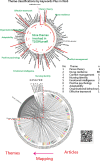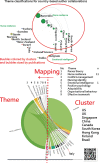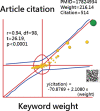Classification and citation analysis of the 100 top-cited articles on nurse resilience using chord diagrams: A bibliometric analysis
- PMID: 36930064
- PMCID: PMC10019250
- DOI: 10.1097/MD.0000000000033191
Classification and citation analysis of the 100 top-cited articles on nurse resilience using chord diagrams: A bibliometric analysis
Abstract
Background: Studies of most-cited articles have been frequently conducted on various topics and in various medical fields. To date, no study has examined the characteristics of articles associated with theme classifications and research achievements of article entities related to nursing resilience. This study aims to graphically depict the characteristics of the 100 top-cited articles addressing nurse resilience (T100NurseR), diagram the relationship between articles and author collaborations according to themes extracted from article keywords, and examine whether article keywords are correlated with article citations.
Methods: T100NurseR publications were retrieved from the Web of Science (WoS) core collection on October 13, 2022. Themes associated with articles were explored using coword analysis in WoS keywords plus. The document category, journal ranking based on impact factor, authorship, and L-index and Y-index were used to analyze the dominant entities. To report the themes of T100NurseR and their research achievements in comparison to article entities and verify the hypothesis that keyword mean citation can be used to predict article citations, 5 visualizations were applied, including network diagrams, chord diagrams, dot plots, Kano diagrams, and radar plots.
Results: Citations per article averaged 61.96 (range, 25-514). There were 5 themes identified in T100NurseR, including Parses theory, nurse resilience, conflict management, nursing identity, and emotional intelligence. For countries, institutes, departments, and authors in comparison of category, journal impact factor, authorship, and L-index scores, Australia (129.80), the University of Western Sydney (23.12), Nursing (87.17), and Kim Foster (23.76) are the dominant entities. The weighted number of citations according to Keywords Plus in WoS is significantly correlated with article citations (Pearson R = 0.94; P = .001).
Conclusion: We present diagrams to guide evidence-based clinical decision-making in nurse resilience based on the characteristics of the T100NurseR articles. Article citations can be predicted using weighted keywords. Future bibliographical studies may apply the 5 visualizations to relevant studies, not being solely restricted to T100NurseR.
Copyright © 2023 the Author(s). Published by Wolters Kluwer Health, Inc.
Conflict of interest statement
The authors have no conflicts of interest to disclose.
Figures






Similar articles
-
Using chord diagrams to explore article themes in 100 top-cited articles citing Hirsch's h-index since 2005: A bibliometric analysis.Medicine (Baltimore). 2023 Feb 22;102(8):e33057. doi: 10.1097/MD.0000000000033057. Medicine (Baltimore). 2023. PMID: 36827008 Free PMC article.
-
A leading bibliometric author does not have a dominant contribution to research based on the CJAL score: Bibliometric analysis.Medicine (Baltimore). 2023 Jan 13;102(2):e32609. doi: 10.1097/MD.0000000000032609. Medicine (Baltimore). 2023. PMID: 36637941 Free PMC article.
-
Thematic maps with scatter and 4-quadrant plots in R to identity dominant entities on schizophrenia in psychiatry since 2017: Bibliometric analysis.Medicine (Baltimore). 2023 Nov 17;102(46):e36041. doi: 10.1097/MD.0000000000036041. Medicine (Baltimore). 2023. PMID: 37986352 Free PMC article.
-
Thematic analysis of articles on artificial intelligence with spine trauma, vertebral metastasis, and osteoporosis using chord diagrams: A systematic review and meta-analysis.Medicine (Baltimore). 2022 Dec 30;101(52):e32369. doi: 10.1097/MD.0000000000032369. Medicine (Baltimore). 2022. PMID: 36596060 Free PMC article.
-
Identifying Trends in the Most Cited Nursing Articles: Research Topics, Author Gender Representation and Characteristics Correlated With Citation Counts.J Adv Nurs. 2025 Jun;81(6):2874-2884. doi: 10.1111/jan.16562. Epub 2024 Oct 23. J Adv Nurs. 2025. PMID: 39441031 Free PMC article. Review.
Cited by
-
Trends and hotspots related to traditional and modern approaches on acupuncture for stroke: A bibliometric and visualization analysis.Medicine (Baltimore). 2023 Dec 1;102(48):e35332. doi: 10.1097/MD.0000000000035332. Medicine (Baltimore). 2023. PMID: 38050290 Free PMC article.
-
Exploring the top-cited literature in telerehabilitation for joint replacement using the descriptive, diagnostic, predictive, and prescriptive analytics model: A thematic and bibliometric analysis.Medicine (Baltimore). 2023 Dec 1;102(48):e36475. doi: 10.1097/MD.0000000000036475. Medicine (Baltimore). 2023. PMID: 38050200 Free PMC article.
-
A modern approach with follower-leading clustering algorithm for visualizing author collaborations and article themes in skin cancer research: A bibliometric analysis.Medicine (Baltimore). 2023 Nov 3;102(44):e34801. doi: 10.1097/MD.0000000000034801. Medicine (Baltimore). 2023. PMID: 37933006 Free PMC article.
-
Citation Network Analysis of Nurse Staffing Research from the Past Two Decades: 2000-2022.Healthcare (Basel). 2023 Nov 27;11(23):3050. doi: 10.3390/healthcare11233050. Healthcare (Basel). 2023. PMID: 38063618 Free PMC article.
-
A Concept Analysis of Change Fatigue Among Nurses Based on Walker and Avant's Method.J Nurs Manag. 2024 Nov 22;2024:8413242. doi: 10.1155/jonm/8413242. eCollection 2024. J Nurs Manag. 2024. PMID: 40224864 Free PMC article.
References
-
- The COVID-19 effect: World’s nurses facing mass trauma, an immediate danger to the profession and future of our health systems. Available at: https://www.icn.ch/news/covid-19-effect-worlds-nurses-facing-mass-trauma... [access date February 2, 2023]
-
- Kolodzey L, Trbovich P, Kashfi A, et al. . System factors affecting intraoperative risk and resilience: applying a novel integrated approach to study surgical performance and patient safety. Ann Surg. 2020;272:1164–70. - PubMed
-
- Strengthening resilience: a priority shared by health 2020 and the sustainable development goals. Available at: https://www.euro.who.int/__data/assets/pdf_file/0005/351284/resilience-r... [access date October 22, 2022].
MeSH terms
LinkOut - more resources
Full Text Sources

